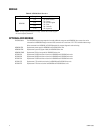
6 C3683M (3/09)
Description
The NSM5200 Series network storage manager (NSM) delivers industry leading performance and innovation for mission-critical storage needs.
The combination of high performance, scalable hardware design and advanced software capabilities enables the NSM5200 to meet the unique
storage needs of physical security and video surveillance applications.
Hardware Built for Performance, Reliability, and Scalability
The demands of real-time video and audio recording place unique strains on storage subsystems. Storage systems require the bandwidth and
capacity to keep up with incoming video streams. They must also simultaneously manage all other common disk and RAID functions as well as
video streams that need to be recorded and played back on a constant basis. In addition, physical security applications are almost always
mission critical. Any downtime, degraded performance for routine maintenance, or loss of recorded footage is extremely disruptive to the
organization's physical security mission.
The NSM5200 has been engineered to meet these unique performance and reliability demands. Custom hardware components, to eliminate
common performance choke points to a patented scheme for writing content to a disk drive, have been specifically designed to deliver sustained
high throughput for recording and playback. The NSM5200 is capable of a maximum of 250 Mbps of throughput for incoming streams while
delivering 32 simultaneous playback streams when failover is not implemented. This performance is maintained whether the system is operating
in normal conditions, dealing with disk drive errors, or rebuilding the RAID array.
The NSM5200 improves the total cost of ownership and energy efficiency by consolidating disparate components into a single chassis. The
250 Mbps throughput provides double the improvement over Pelco's first generation recorder, allowing users to service far more cameras in one
storage unit than previously possible. In addition, with the integration of a traditional network video recorder (NVR) server into the storage
chassis, cost and energy efficiency is optimized by eliminating the need for additional servers and the associated heating, ventilation, and
cooling costs. Finally, the use of lower power components and adaptive cooling inside the chassis manage power dissipation based on load
requirements. Reliability is enhanced through the use of redundancy at all common failure points. A CompactFlash (CF) card is used to host the
operating system for higher reliability than traditional hard disk drives. To mitigate any downtime resulting from CompactFlash errors, the
database is striped across the storage array. The RAID 6 storage configuration provides double parity protection of recorded data. The hard drive
bay is cooled through the use of high capacity, redundant fans to ensure that the drives are kept at an optimum operating temperature. Finally,
fully redundant power supplies guard against any power supply failure.
As with any other system, maintenance is an important and vital part of sustained operation. The NSM5200 incorporates various innovations to
make maintenance more efficient and to allow the system to continue operating at peak performance levels. Easy access to hard disk drives and
the CompactFlash card is available from the front panel. A unique rail system allows access to a failed fan should it need to be replaced.
Temperature sensors throughout the chassis detect possible airflow obstruction or clogged intake filters. The use of enterprise-class SAS
®
technology provides advanced enclosure management and monitoring. Notifications of potential or actual issues are transmitted to the Endura
®
user interfaces for action. Storage capacity is scaled using DAS5200 direct attached storage (DAS) units. Utilizing the high reliability of a SAS
backplane and connections, up to seven DAS5200s can be connected to a single NSM5200. With up to 12 TB of raw capacity in each storage
element, each NSM5200 can reach a maximum of 96 TB of raw capacity.
Software Built for Flexibility, Reliability, Cost Optimization
In addition to unique strains placed on hardware components, video surveillance applications also demand innovations in software. Recording
software must accommodate automatic failover should a catastrophic failure occur. Recording software must deal with file fragmentation
caused by overwrite, locking of video clips, and managing metadata associated with alarms and events. Finally, recording software must deal
with the escalating cost of storage by finding innovative ways to manage recorded content. This ensures that the user extracts the most value
from the cost of the storage subsystem.
The NSM5200 supports pooling of multiple recorders to provide for automatic load balancing and failover. A single storage pool can support up
to 512 cameras. One of the NSM5200s in the pool acts as the master and manages camera assignments, health monitoring, and redistribution of
the recording load. Should a unit fail, the given cameras are automatically redistributed to the remaining units in the storage pool. When the
failed unit is brought back on line, the recording load is distributed again such that the load on any given recorder is balanced. This capability
also allows users to dynamically add additional storage to a pool as their retention needs change.
The NSM5200 incorporates an improved version of Pelco's patented EnduraStor™ storage optimization technology. EnduraStor was developed to
manage the cost of storing high resolution, high frame rate video by leveraging the fact that the value of recorded video is typically higher
immediately following an incident. Organizations are capable of specifying a desired delay period during which all recorded video will be kept at
30 images per second (25 for PAL). As the age of video available on hard disk drives exceeds the delay period, it is automatically groomed to a
lower frame rate, thus freeing up storage capacity for new video. The NSM5200 incorporates advancements in the EnduraStor algorithm, which
gives administrators the option of classifying the priority level of alarm or event video to retain the full frame.
The NSM5200 is built upon the proven stability and robustness of its Linux
®
-based operating system. It utilizes an XFS file structure and
automated defragmentation routines to keep the database from becoming fragmented. XFS has been proven to be a more superior file format for


















